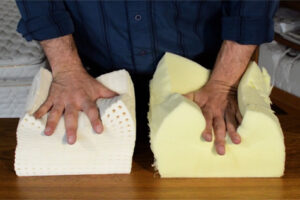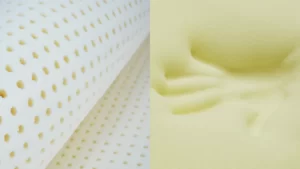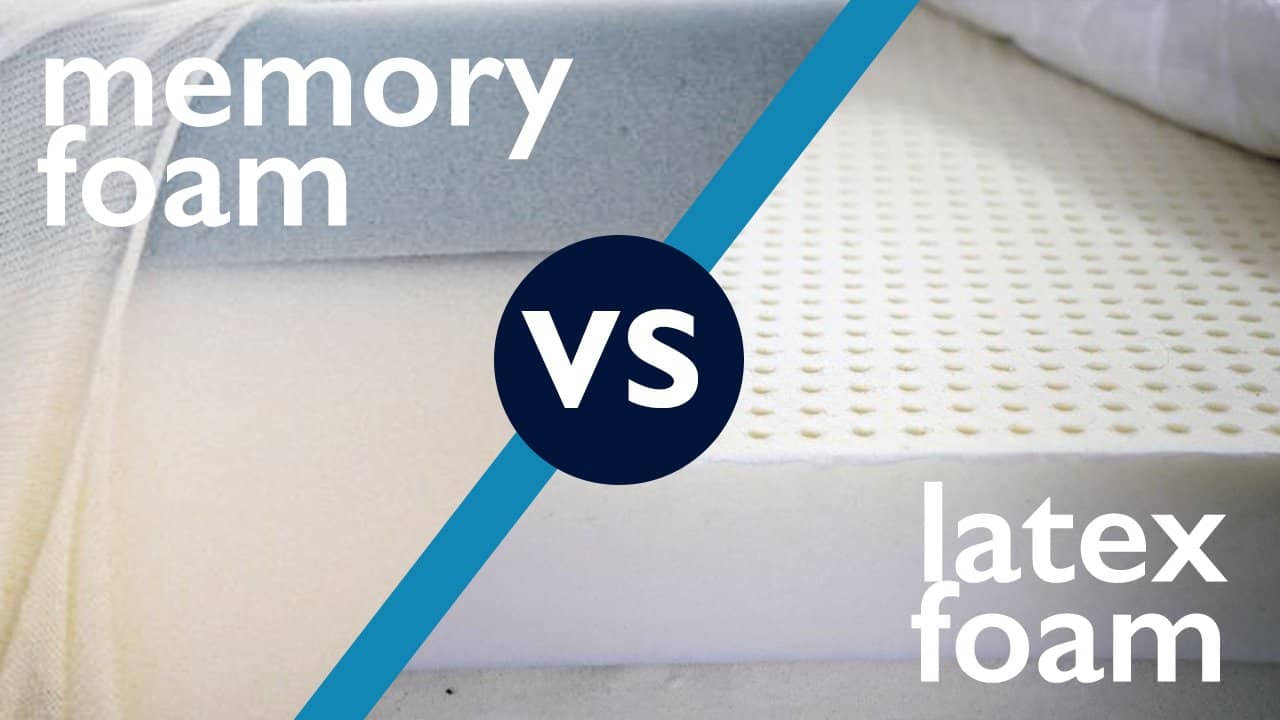What is the Difference Between Memory Foam and Latex Mattresses?
With so many mattress options out there, it can be difficult to decide which one is best for you. But for those who have heard about memory foam and latex mattresses, the decision may not be so clear.
The mattress industry is constantly changing, and the number of options available today is more than ever before. Memory foam and latex mattresses have become increasingly popular choices due to their superior comfort and support benefits for sleepers.
If you’re considering buying a new mattress but don’t know what type to get, it’s worth taking some time to research your options. In this article, we will discuss the key differences between memory foam and latex mattresses that can help you make an informed decision on which product is right for you.
What is Memory Foam?
Memory foam is a type of synthetic material made up of polyurethane and other chemicals. It was developed by NASA in the 1970s to provide cushioning for astronauts during lift-off. Since then, it has become increasingly popular in mattresses, pillows, and other products due to its ability to contour to the body’s shape and distribute weight evenly.
Memory foam is also known for its ability to reduce motion transfer between people sleeping on the same mattress, making sleep more comfortable. Memory foam offers superior pressure relief and support than traditional materials like springs or coils. It also tends to last longer meaning that you don’t have to replace your mattress as often as you would with a traditional spring mattress.
What is Latex?
Latex is a natural material made from the sap of rubber trees. It is often used in mattresses, pillows, and other products due to its superior comfort and breathability. Latex mattresses are known for their ability to conform to the body’s shape while providing superior pressure relief and support.
Additionally, natural latex mattresses are hypoallergenic making them ideal for people with allergies or sensitive skin. Latex also offers excellent motion isolation, meaning that it absorbs movement rather than transferring it across the mattress surface like traditional spring mattresses can do.
Finally, because latex is a natural material, it’s an eco-friendly choice that doesn’t contain any synthetic materials or chemicals. With proper care, latex mattresses can last up to 10 years or more so you won’t have to replace your mattress as often as you would with a traditional spring mattress.
Differences Between Memory Foam and Latex Mattresses
Memory foam and latex mattresses are both popular mattress types that offer different benefits to those who sleep on them. Memory foam mattresses are made of polyurethane foam with added chemicals like viscoelastic and gel that give it its unique properties. This type of mattress is best known for its ability to contour to the body’s shape, providing superior pressure relief and support. It also offers excellent motion isolation which makes it a good choice for couples as it absorbs movement rather than transferring it across the bed.
Additionally, memory foam mattresses have no off-gassing due to their lack of chemical components so they are safe for those with allergies or sensitivities.
Latex mattresses, on the other hand, are made from the sap of rubber trees and provide superior comfort and breathability due to their natural materials. Latex is known for conforming to the body’s shape while providing excellent pressure relief and support in addition to excellent motion isolation making it great for couples too. Latex is also hypoallergenic making it ideal for people with allergies or sensitive skin.
Finally, latex is an eco-friendly choice since it’s a natural material and can last up to 10 years or more with proper care so you won’t have to replace your mattress as often as you would with traditional spring mattresses.
Original Shape and Motion Transfer
Original Shape and Motion Transfer are two important features to consider when shopping for a new mattress. Original shape refers to how well the mattress will retain its original shape after it has been used. Memory foam mattresses are typically best for this because they can conform to the body’s shape over time and then return back to their original form when pressure is removed. Latex mattresses, on the other hand, have a more resilient surface that springs back into shape quickly after use.
Motion transfer is also an important factor to consider when shopping for a new mattress. This refers to how much movement is transferred across the bed when one person moves or gets out of it. Memory foam mattresses provide excellent motion isolation as they absorb movement rather than transferring it across the bed, making them an ideal choice for couples who share a bed. Latex mattresses also provide good motion isolation but may not be as effective as memory foam in absorbing movement.
Pressure Relief
Pressure relief is an important factor to consider when shopping for a mattress. Pressure relief refers to how well the mattress relieves pressure points in the body, such as your hips and shoulders, while you sleep. Memory foam mattresses are excellent at contouring the body and providing support where it’s needed most, making them great for those who suffer from chronic pain or joint stiffness.
Latex mattresses also provide good pressure relief but they may not be as effective as memory foam in this area. To experience maximum pressure relief, look for mattresses that combine both memory foam and latex layers. This combination of materials allows for optimal comfort and support while still providing excellent motion isolation.

Response Time
Response time is a key factor to consider when choosing the right mattress. Response time is a measure of how quickly the mattress responds to your body’s movements. Memory foam mattresses tend to have slower response times, which can be beneficial for those who sleep on their sides or back as it helps reduce pressure points and keeps the spine properly aligned.
On the other hand, latex mattresses are known for their quick response times, which is ideal for those who sleep on their stomach as it reduces sinkage and minimizes motion transfer. Combination mattresses that feature both memory foam and latex layers also provide a good balance between comfort and support, allowing you to experience the best of both worlds.
Heat Retention
Heat retention is an important factor to consider when choosing a mattress. Memory foam mattresses tend to be more prone to heat retention, which can make them uncomfortable for some people. This is because memory foam reacts to body heat and can become very warm if you’re not sleeping in a cool environment. On the other hand, latex mattresses are known for their better breathability and air circulation, making them a much cooler option than memory foam.
Latex also contains pinhole-sized holes that allow hot air to escape while still providing adequate support and comfort. If you’re looking for a mattress that won’t trap too much of your body heat, then latex may be the best choice for you.
Pain Relief
When it comes to pain relief, many people are turning to mattresses for help. Memory foam and latex mattresses are two popular options for finding comfort and support. While both types of mattresses offer great benefits, there are some key differences between them that might affect your choice.
Memory foam is known for its contouring capabilities and pressure point relief. It molds to the body’s shape in order to provide support and cushioning at key areas like the hips, shoulders, and back. This helps alleviate discomfort from chronic conditions such as arthritis or fibromyalgia. Latex mattresses are also great for pain relief due to their natural elasticity and springiness. They provide a buoyant feeling that helps reduce joint strain while still giving you the necessary support.
Overall, both memory foam and latex mattresses can provide excellent levels of pain relief depending on your individual needs. Consider talking with a doctor or mattress expert if you have any questions before making a decision.
Durability
When it comes to durability, both memory foam and latex mattresses can be reliable options depending on the quality of their construction. Memory foam mattresses tend to last longer due in part to their dense material makeup. Latex mattresses are also very durable but they may require more frequent flipping or rotating to ensure even wear over time. For those looking for an extra-durable mattress, a combination of both materials may be the best choice.
Choosing between memory foam and latex mattresses can be difficult, but understanding the differences between them can help you make a more informed decision. Both types of mattresses offer excellent levels of comfort and support, but one may be better suited for your individual needs than the other. Consider factors like pain relief, response time, heat retention, and durability when comparing the two materials.
Price
When it comes to price, the cost of a memory foam or latex mattress can vary greatly. Memory foam mattresses tend to be more affordable than latex mattresses, however, they may not last as long as their more expensive counterparts. Latex mattresses typically come with a higher price tag but have excellent durability and longevity if cared for properly. Combination mattresses that feature both memory foam and latex layers are also available but tend to be at the higher end of the price range.
Care and Maintenance
Caring for a memory foam or latex mattress is an important part of making sure it lasts as long as possible. Memory foam mattresses should be vacuumed regularly to remove dust and debris, while latex mattresses should be flipped or rotated at least once every three months. Both types of mattresses should also be covered with a protective mattress pad in order to prevent dirt and stains. Regular cleaning and maintenance will help ensure that your mattress remains comfortable and supportive for many years to come.
Environmental Impact
When considering a memory foam or latex mattress, it’s important to consider the environmental impact of each material. Memory foam mattresses typically contain polyurethane foam which is made from petroleum-based chemicals. Latex mattresses, on the other hand, are often made from natural rubber tree sap and are biodegradable when disposed of properly. Additionally, many latex mattresses are also certified organic, meaning they’re free from harmful pesticides and other chemicals.
When shopping for the right mattress, it’s important to consider the many factors involved. Think about how each material will affect your sleep and comfort, as well as its environmental impact. Consider your budget and prioritize features that are most important to you such as pain relief and durability. Lastly, talk with a qualified professional if you have any questions or doubts so you can make an educated decision on which mattress is right for you.
Natural vs Synthetic Materials
When it comes to mattress materials, natural and synthetic are two popular choices. Natural materials like latex and wool are often considered more comfortable and durable than synthetic options. They provide a breathable sleep experience that helps regulate body temperature and reduce moisture buildup. Natural materials also tend to be free of harmful chemicals and allergens, making them an ideal choice for people with allergies or sensitive skin.
On the other hand, synthetic mattresses are generally less expensive than their natural counterparts. They can be made from a variety of materials such as polyester, rayon, or viscose. Synthetic mattresses often have a firmer feel than natural models due to their tighter weave design. While they may not be as breathable or comfortable as natural ones, they can still provide adequate support at a more affordable price point.
Ultimately, both natural and synthetic mattress materials have advantages and drawbacks depending on your needs and budget. Consider doing research online or talking with a mattress expert before making a decision on which type is right for you.
See also
Frequently Asked Questions
Frequently Asked Questions About Mattresses
Purchasing a new mattress can be overwhelming, so it’s important to ask the right questions. Here are some of the most commonly asked questions about mattresses:
1. What type of mattress is best for me?
The best type of mattress for you depends on your sleeping habits and preferences. If you prefer a firmer feel, then synthetic materials may be a better option. If you like more cushioning, natural materials such as latex or wool may be the way to go.
2. How long will my mattress last?
On average, memory foam mattresses have an estimated lifespan of 10 years while latex mattresses can last up to 20 with proper care. However, this time frame can vary depending on the quality and brand of your mattress.
3. Are there any health benefits associated with certain types of mattresses?
Yes! Natural materials such as latex and wool are often considered more breathable than synthetic options, which helps regulate body temperature during sleep and reduce moisture buildup. Plus, natural mattresses tend to be free from harmful chemicals and allergens, making them an ideal choice for people with allergies or sensitive skin.
When shopping for a new mattress, it’s important to consider how it will fit into your lifestyle. Think about how much time you spend in bed if you have any specific sleep needs, and how often you plan to rotate or flip the mattress. Also, think about what type of support and cushioning is most comfortable for you. Knowing these factors can help you narrow down your options and make the best decision for your sleep needs.

Mattress Testing and Reviews
When it comes to mattress testing and reviews, there are a few things to consider. First, look for unbiased reviews from experts who have tested the mattress in person. If a mattress has been tested by an independent third-party organization, such as Good Housekeeping or Consumer Reports, it’s likely to be reliable. Additionally, read online reviews from verified customers to get a better idea of how the mattress feels and performs in real life. Finally, make sure to read the warranty information carefully before making your final decision.
When it comes to purchasing a new mattress, it’s important to find one that meets your individual needs and preferences. It’s best to try out different models in person before making a purchase so you can get a feel for the materials and support they offer. If you can’t test the mattress in person, consider reading customer reviews and researching different brands to find out more about their features and benefits. With a little bit of research, you can find the perfect mattress to suit your unique sleeping needs.
When shopping for a mattress, it’s important to think about how you want it to feel. Consider the type of support you need and what level of firmness is most comfortable for you. Also consider the motion isolation that different materials offer, as some mattresses are better at reducing motion transfer than others. Additionally, look into the breathability offered by certain mattress materials, as this can help keep you cool and comfortable throughout the night. Lastly, read up on the quality of materials used in each mattress to make sure it will last for years to come.
When it comes to choosing between memory foam and latex mattresses, there are several factors to consider. Memory foam is known for its contouring ability, which helps to provide pressure relief and reduce pain. However, it can also retain heat, making it less breathable than latex alternatives. In contrast, latex mattresses are very supportive and offer excellent breathability due to their open cell structure.
When comparing memory foam and latex mattresses, it’s important to consider your individual sleeping needs and preferences. Consider the type of support you need, whether you prefer a softer or firmer mattress, and how much motion transfer you want to experience. Additionally, take into account factors like breathability and temperature control when making your decision. Ultimately, it comes down to personal preference so make sure of the breathability and durability of each mattress material so you can make the best decision for your unique sleeping needs.
Is latex or memory foam better for back pain?
Deciding between a latex or memory foam mattress for back pain can be difficult. Both materials can help reduce pain and improve comfort, depending on the individual sleeper and the overall firmness of the mattress. Memory foam mattresses are known for providing contouring support which helps to reduce pressure points that can cause aches and pains. Latex mattresses, on the other hand, provide more bounce with their springy nature and tend to be more breathable.
Ultimately, it comes down to personal preference as there is no one size fits all solution when it comes to mattresses and back pain. If you’re not sure which type is right for you, take some time to test them out in-store or order online with a trial period so you can see how your body responds to each option. With a little research and experimentation, you should be able to find a mattress that helps provide relief from your back pain.

Are latex beds good for side sleepers?
Latex beds can be a great option for side sleepers who need more contouring and pressure relief. Unlike memory foam, latex mattresses have a more springy feel that conforms to the body without sinking too deeply. This can provide better spinal alignment and reduce the number of pressure points that can cause aches and pains in side sleepers.
Additionally, latex beds tend to be more breathable than memory foam, helping keep you cool while you sleep. Ultimately, it all comes down to personal preference as some people prefer the feeling of memory foam while others may prefer the bounciness of latex. If you’re not sure which one is best for you, take some time to test them out in-store or order online with a trial period so you can see how your body responds to each option.
Conclusion
In conclusion, both memory foam and latex mattresses can provide a comfortable and supportive sleep surface. Memory foam conforms to the body more deeply and provides excellent pressure relief while latex has a more springy feeling that is better for spinal alignment. Ultimately, it all comes down to personal preference as everyone has different needs when it comes to their mattress. If you’re not sure which one is right for you, be sure to test them out in-store or order online with a trial period so you can see how your body responds to each option.












Leave a Reply